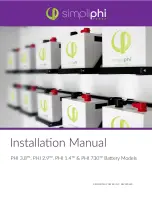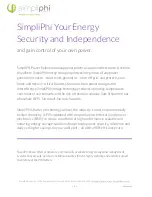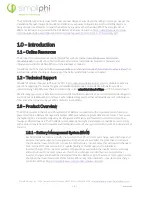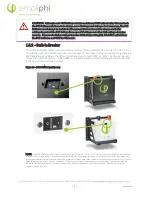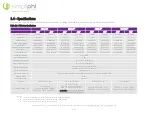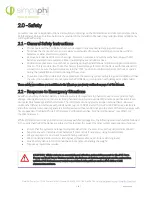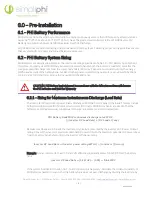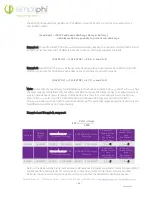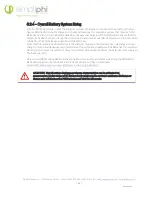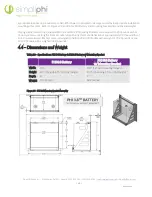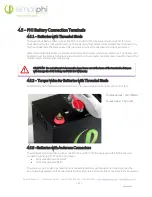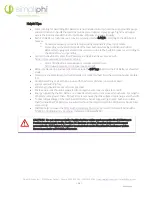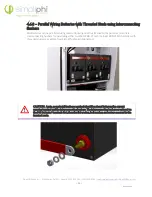
REV020620
SimpliPhi Power, Inc. | 3100 Camino Del Sol | Oxnard, CA 93030, USA | (805) 640-6700 |
| 8 |
2.0
–
Safety
For safety reasons, read all instructions and cautionary markings on the PHI Batteries, and all appropriate sections
of this manual. Failure to follow instructions provided in the Installation Manual, Integration Guides and Warranty
will Void the Warranty.
2.1
–
General Safety Instructions
•
Do not operate if the PHI Battery has been damaged in any way during shipping or otherwise.
•
To reduce the chance of short-circuits, always use insulated tools when installing or working with PHI
batteries or other electrical equipment.
•
Remove personal metal items such as rings, bracelets, necklaces, and watches when working with PHI
batteries and electrical equipment. Wear insulated gloves and rubber shoes.
•
PHI Batteries pose some risk of shock or sparking during the installation and initial wiring and connection
process. This is consistent with all other battery-based storage formats. For batteries with threaded stud
connections, be sure the built-
in breaker is in the “OFF” position to minimalize the risk of shock or sparks
during the installation and commissioning of the system.
•
To avoid a risk of fire and electric shock, make sure that existing system wiring is in good condition and that
the wire is not undersized. Do not operate the PHI Battery in conjunction with damaged or substandard
wiring.
These safety precautions are in addition to the Warnings previously outlined on page 4 of this Manual.
2.2
–
Response to Emergency Situations
As with any battery, if the PHI Battery’s cells are severely damaged due to physical abuse, reverse polarity, high
voltage, unmitigated current or other electrical phenomenon incurred outside of Warranted specifications, it can
cause electrolyte leakage and other failures. The electrolyte can be ignited by an open external flame. However,
unlike other lithium ion batteries with cobalt oxides (e.g. LCO, NCM and NCA), the PH
I LFP Batteries’ electrolyte
and other material components generate a limited amount of heat and do not go into a state of thermal runaway with
fire propagation. The SimpliPhi UL 1973 Battery Certification verifies “No Thermal Runaway” (see MSDS for
chemical analyses).
While PHI Batteries do not go into thermal runaway with fire propagation, the following protocol should be followed
in the event that the PHI batteries are subjected to electrical fire caused by other system components or failures:
•
Ensure that the system is no longer energized, either from the solar array or the grid (main disconnect).
•
Separate any external cables from batteries if present (cut if necessary) using insulated tools.
•
Wear a respirator or dust mask to avoid inhaling soot/dust.
•
Wear insulating and abrasion-resistant gloves (if permeable, over nitrile or similar gloves).
•
Move battery debris into non-conductive bins capable of handling the weight.
•
Dispose as regulations require.
CAUTION: While water is an acceptable and effective extinguishing agent for the PHI Core
Power and Peak Power Battery models, the Balance of System equipment used in conjunction
with the PHI Batteries may require specialized extinguishers such as FM-200 or CO2
suppression systems.

